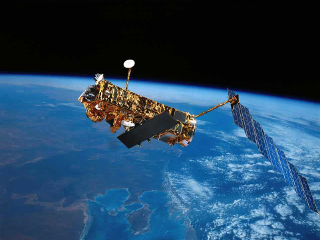The ESA’s Environmental Satellite (EnviSat) is the largest civilian Earth Observation satellite ever built. The mission objectives covered a wide range of disciplines, for both meteorological and climatological studies: EnviSat gathered information on regional and global scale phenomena, strongly contributing to a better understanding of oceans, atmosphere, vegetation, Earth crust, hydrology, and ice processes. EnviSat was launched in March 2002, with a near-circular sun-synchronous orbit of altitude 800 km and a spatial coverage of ±81.45° (inclination 98.55°). The orbit had an exact repeat cycle of 35 days and the same ground track as ERS-2 (within ±1 km) . On May 2012, EnviSat mission was officially declared terminated.
 Envisat (Credit: ESA)
Envisat (Credit: ESA)